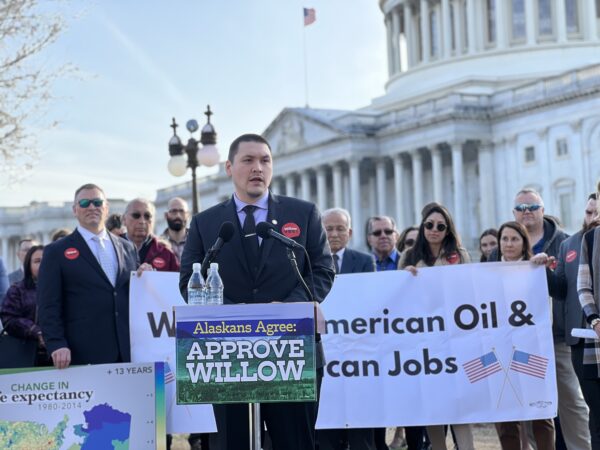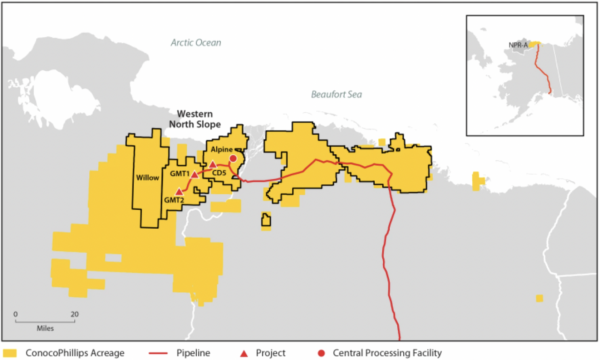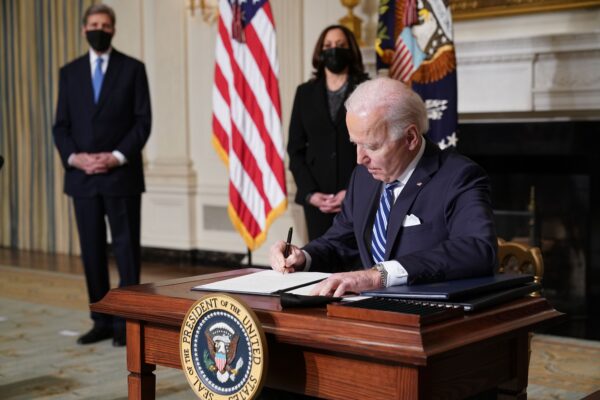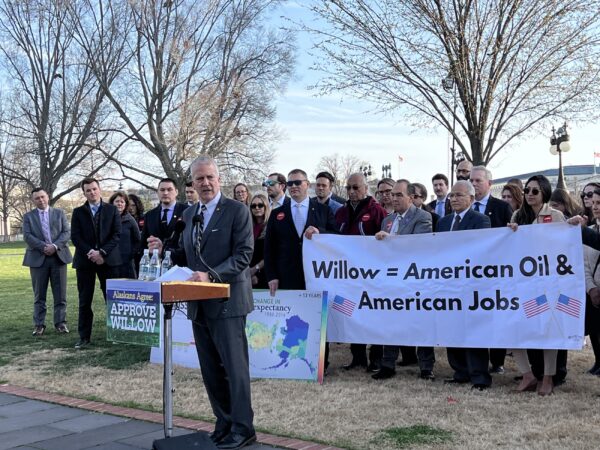Biden Finds No Olive Branches on Alaska’s North Slope in Pending Willow Decision
President Joe Biden is stuck between Alaska’s North Slope and a hard place in pondering his pending decision to deny or endorse Conoco-Phillips’ $8 billion Willow Project, the largest new oil field development proposed in the United States in decades.
Among Biden’s 2020 campaign pledges was “no, no, no more” new oil drilling on federal public lands, a key component in his plan to halve the nation’s carbon emissions by 2030.
But under his administration, federal agencies have defended the massive project’s Trump Era approval in court. After a judge stayed the approval in 2021, it endorsed a scaled-down version that would still be the largest single-project oil extraction on federal lands in the nation’s history.
Approving the compromise three-pad proposal would anger many Lower 48 Democrats and environmental groups—including the League of Conservation Voters, Sierra Club, and Earthjustice—which were among key vote-generators for Biden’s presidential campaign.

Opponents have launched a #StopWillow petition blitz, convincing more than 50 million Tik-Tok respondents to demand the president kills the project.
Nixing the reapproval would equally enrage a bipartisan amalgamation of conservatives, who see it as vital for national energy security, and a majority of Alaskans, including many from Democrat-leaning constituencies such as trade union members, Native Americans, and Alaska Natives along the North Slope, who say it would benefit, not harm, their communities and subsistence lifestyle.
Both chambers of the Alaska Legislature have unanimously adopted a resolution approving the Willow Project, Gov. Mike Dunleavy is a proponent, and the state’s congressional delegation—Republican Sens. Lisa Murkowski and Dan Sullivan, and Democratic Rep. Mary Peltola—support the project.
On March 1, “an amazing constellation of Alaska royalty” including state lawmakers, union representatives, Native Americans, and Alaskan Natives joined Murkowski, Sullivan, and Peltola in Washington to call on Biden to approve Willow.
“When we talk about environmental justice and protecting the environment, U.S. Alaskan Natives are part of that environment, we always have been and we always will be,” Rep. Josiah Patkotak (I-Barrow) said.
“We’re asking the president, his cabinet, all of those involved in the decision-making process, to keep that in mind because, if there’s any good highlight to ‘environmental social governance’ (ESG), this Willow project represents that.”

“The Biden administration must listen to Alaska’s indigenous voices,” said Dorian Levitz, natural resources director for the Inupiat community of Arctic Slope. “Not supporting and passing Willow would not be in support of our indigenous people.”
“Mr. President, hear our voices, this is a no-brainer on so many fronts,” Sullivan beseeched. “Mr. President, if you’re for the working men and women of this country, this is a no-brainer—please let us produce American oil with American workers.”
Alaska AFL-CIO president Joelle Hall, who represents 55 unions and 55,000 workers, called the gathering “quite an interesting event.”
“This is management and labor, Alaska Native corporations, all manner of Alaska organizations standing together, asking the same question—‘Put us to work, put us to work,’” she said. “Mr. President, we want to build this job. We want to build for American security. We want to build American jobs.”
Job-Generating ‘Carbon Bomb’
The proposed Willow Project is within the nation’s largest expanse of federal public lands—the 23-million-acre National Petroleum Reserve-Alaska (NPRA)—on leases granted Conoco-Phillips by the U.S. Bureau of Land Management (BLM) since 1999.
The compromise outlines three 12-acre gravel pads across 556 acres. Each pad, where the project’s 300 workers will live, has a 55-square-mile horizontal drilling radius at 22,000 feet deep. The company plans to extent pad drilling radius to 154-square-miles, and go as deep as 37,000 feet below the tundra, during the project’s 30-year lifespan.
Texas-based Conoco-Phillips will spend up to $8 billion to build the roads, pipelines, and 219 wells that will stem downward from the three pads that will require hiring 2,500 Alaskan construction workers, “the toughest humans on the planet,” Hall said.

The company forecasts Willow will produce up to 180,000 barrels of oil a day, about 1.5 percent of total U.S. oil production. Over its three-decade lifespan, it will produce more than 600 million barrels of oil and generate up to $17 billion in revenues for the federal government, Alaska, the North Slope Borough, and North Slope communities, Conoco-Phillips maintains.
Opponents call the Willow Project “a carbon bomb” noting, by the BLM’s analysis, it would produce enough oil to release 9.2 million metric tons of carbon into the atmosphere a year, the equivalent to the combined emissions of 2 million gas-powered cars.
Over the course of 30 years, the BLM calculates, Willow would release an estimated 278 million metric tons of carbon, which opponents say is more than 70 coal-fired power plants could produce every year.
Any Day Now
Conoco-Phillips submitted its initial five-pad proposal in 2018. It was approved by the Trump administration’s Department of the Interior (DOI) in October 2020.
Earthjustice was among the groups that legally challenged the BLM’s environmental impact statement (EIS) approving the project. The Biden administration’s Justice Department defended the EIS in court proceedings.
In August 2021, a federal judge stayed approval and returned the EIS to the BLM for revision, ordering it be ready within 18 months.
The BLM issued its renewed review on Feb. 1, recommending in its “preferred alternative” to the original approval that Willow be re-approved, but scaled back from five to three pads.

The BLM’s recommendation prompted the DOI to issue a statement identifying “substantial concerns” with Willow, “including direct and indirect greenhouse gas emissions and impacts to wildlife and Alaska Native subsistence.”
The DOI said BLM’s “preferred alternative” does not constitute “a decision about whether to approve the Willow Project,” which it said will be made by Secretary of the Interior Deb Haaland.
Following a 30-day public comment period after the BLM published its revised EIS on Feb. 1, which expired on March 2, a decision could come anytime in the coming days.
And that decision won’t come from Haaland’s DOI office in the Stewart Lee Udall Building in Washington’s Foggy Bottom neighborhood but from the Oval Office in the White House.
Two-Pad Deal-Killer Ahead?
There is widespread speculation based on alleged comments from unnamed White House officials that Biden may approve the project, but further reduce it to two pads while imposing a new ban on drilling in the Arctic Ocean off Alaska’s North Slope and implementing a range of mitigative efforts across the state.
Proponents argue that by reducing the Willow Project to two pads, the Biden administration would be trying to have it both ways—a deceitful approach that technically approves the project, but makes it economically unviable.
“If they go to two pads, we have told them we will view it 100 percent as a full denial,” Sullivan said. “Conoco has made it clear it would not be economically viable, and we have warned the White House: Don’t try to be cute.”
“They seem to be agonizing over whether or not they should allow for a reapproval. This is a reapproval. There is nothing to agonize here,” Murkowski said.
“This is about security for America, security for Alaskans. Get off the dime, administration, approve the Willow Project. It shouldn’t be this hard. It’s doing the right thing. That’s what we’re asking the Biden administration to do.”
Sullivan said a denial or reduction to two pads will elicit legal challenges. Of course, regardless what the decision, lawsuits are guaranteed—Earthjustice already has a new suit teed up.
Conoco-Phillips pays $100 million annually in lease payments and has invested more than $600 million into Willow Project exploration and development.
“So this is not some kind of whim that [the administration] can just say, ‘You know, we’re not going to do it,’” Sullivan said. “They have an obligation under law to do this. And that’s why we’re all here saying approve the EIS that the Biden administration scientists have already approved.”
Denying the project would be buckling to “radical environmental groups” that are demanding Biden “kill this one,” he said, which would serve no purpose other than the display of “political power.”
“Denial of this project would be horrible for America, Alaska, our environment, our workers,” Sullivan said.
“And again, it would make no sense. It wouldn’t be based on any science. It would be based on raw political power, that people are trying to influence the president and others to kill the project. And unfortunately, two pads would win the day on killing the project.”




